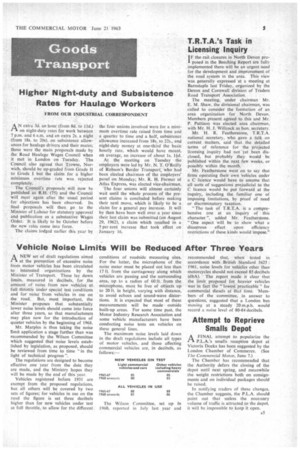Vehicle Noise Limits Will be Reduced After Three Years
Page 7

If you've noticed an error in this article please click here to report it so we can fix it.
ANEW set of draft regulations aimed at the prevention of excessive noise from motor vehicles has been circulated to interested organizations by the Minister of Transport. These lay down limits, measured in decibels, for the amount of noise from new vehicles at full throttle under special test conditions and for noise from vehicles in use on the road. But, most important, the Minister proposes that substantially lower noise levels should come into force after three years, so that manufacturers may plan now for the introduction of quieter vehicles by the beginning of 1968.
Mr. Marples is thus taking the noise limit application a stage further than was recommended by the Wilson Committee which suggested that noise levels established by legislation, as proposed, should be reviewed from time to time "in the light of technical progress ".
The regulations are designed to become effective one year from the date they are made, and the Ministry hopes they will be made by the end of this year.
Vehicles registered before 1931 are exempt from the proposed regulations, but all others will be covered by two sets of figures; for vehicles in use on the road the figure is set three decibels higher than for new vehicles under test at full throttle, to allow for the different conditions of roadside measuring sites. For the latter, the microphone of the noise meter must be placed not less than 17 ft. from the carriageway along which vehicles are passing and the surrounding area, up to a radius of 60 ft. from the microphone, must be free of objects up to 20 ft. in height. varying with distance, to avoid echoes and sound-wave distortions. It is expected that most of these measurements will be made outside built-up areas. For some time past, the Motor Industry Research Association and some vehicle manufacturers have been conducting noise tests on vehicles on these general lines.
The maximum noise levels laid down in the draft regulations include all types of motor vehicles, and those affecting commercial vehicles are, in decibels, as follows:— recommended that, when tested in accordance with British Standard 3425 : 1961, noise levels for vehicles other than motorcycles should not exceed 85 decibels (dbA). The report made it clear that the limit proposed for heavier vehicles was in fact the "lowest practicable" for commercial diesels at that time. Members of the committee, in answer to questions, suggested that a London bus moving at a steady 20 m.p.h. would record a noise level of 80-84 decibels.
Attempt to Reprieve Smalls Depot
A FINAL attempt to popularize the P.L.A.'s smalls reception depot at Victoria Docks has been suggested by the London Chamber of Commerce. (See The Commercial Motor, June 7.)
The Chamber has recommended that the Authority defers the closing of the depot until next spring, and meanwhile the weight restrictions both on consignments and on individual packages should he raised.
In notifying traders of these changes, the Chamber suggests, the P.L.A. should point out that unless the necessary volume of traffic is attracted to the depot, it will be impossible to keep it open.




















































































































